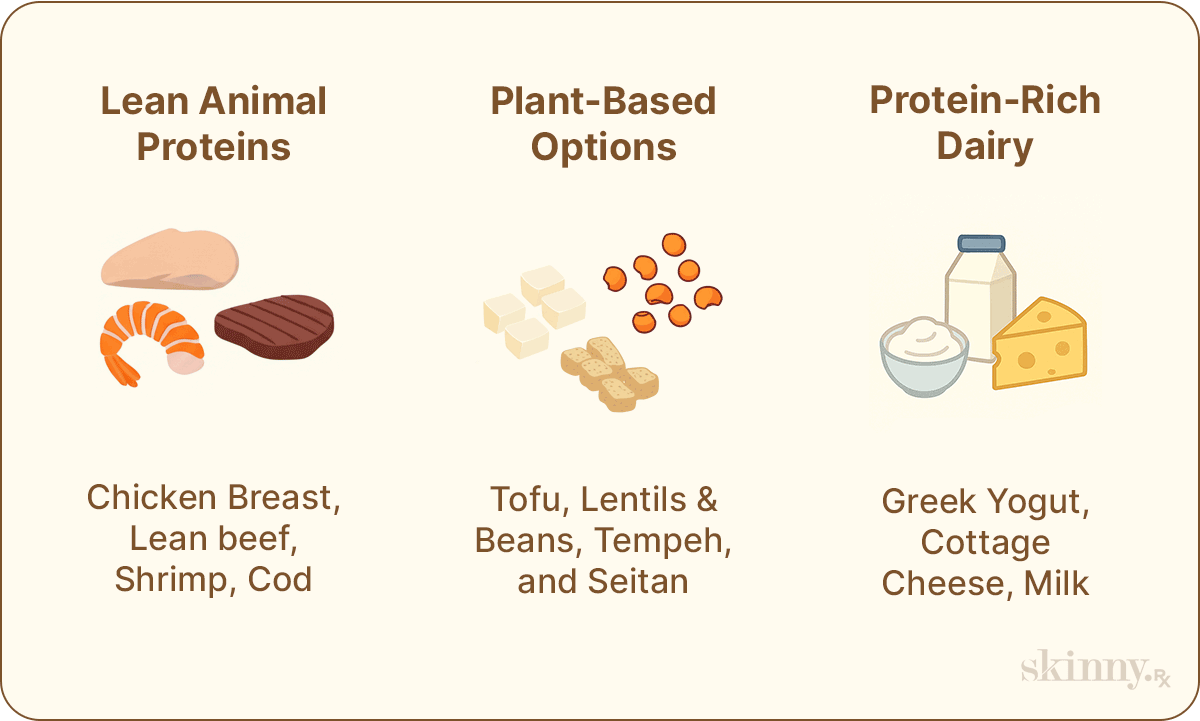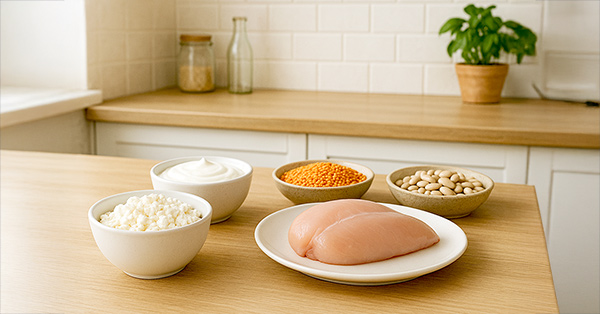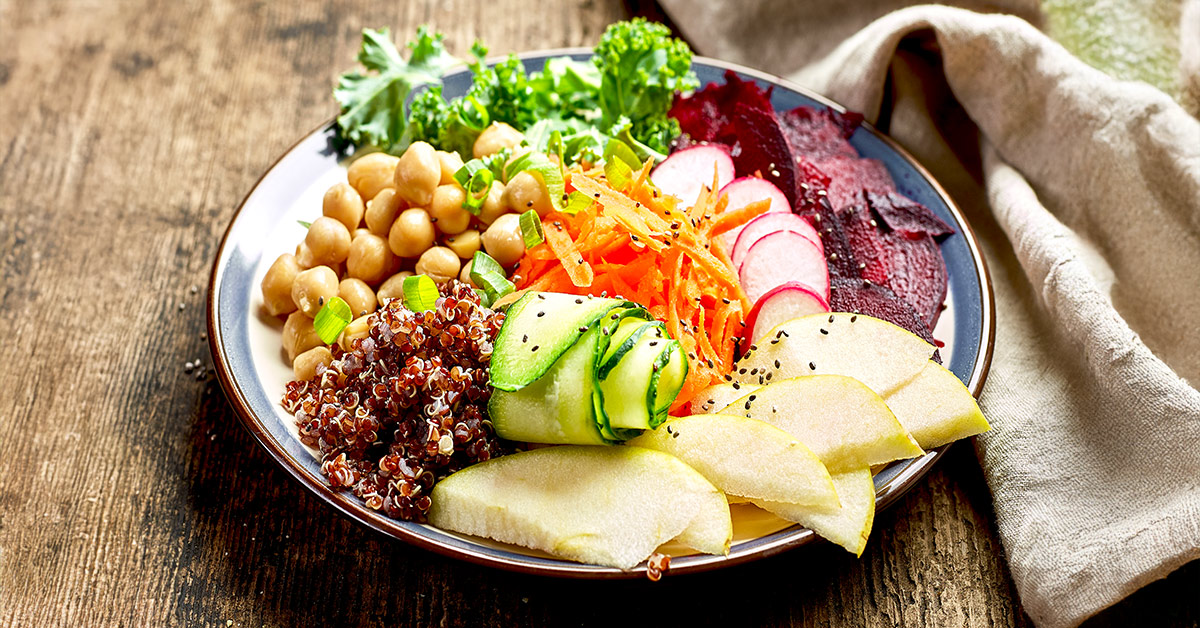
Key Takeaways
- Semaglutide users need 1.2–1.5 g protein per kg body weight daily to preserve muscle mass, supporting physical function and reducing health risks during weight loss.
- High-protein meals help semaglutide users feel full longer by slowing digestion and stabilizing blood sugar levels.
- Lean proteins, such as chicken breast, tofu, or Greek yogurt, and protein powders, are ideal for semaglutide users to meet their protein needs.
- Eating 20–30 g protein (30 g if over 50) across 3–5 daily meals supports muscle retention and hunger control for semaglutide users.
- Balancing protein with fiber-rich carbohydrates and healthy fats, staying hydrated, and eating slowly can help minimize the side effects of semaglutide, such as nausea and constipation.
Weight loss isn’t just about losing weight — you need to maintain as much muscle as you can while you’re at it. No, this article isn’t aimed at bodybuilders preparing for contest day: maintaining a favorable balance of muscle and fat (this is called your body composition) is a key marker of health, which is a reason why exercise is recommended for everybody and not just athletes.
Semaglutide can be effective at reducing appetite, so while you may have once struggled with reducing your intake of certain foods, you may now need to make an effort to maintain or increase your intake of certain foods.
So, you’re losing weight with semaglutide, or you’re considering starting a semaglutide-assisted weight loss plan. That’s great! But there’s work to do to ensure you’re losing the right kind of weight, and protein intake is a key element.
Why Protein Matters on Semaglutide
Preserving muscle while on semaglutide requires a balanced exercise regimen, good sleep habits, and a balanced diet that includes a range of nutrients, but this article is about the most important part of a muscle preservation diet: protein.
Muscle Preservation
Most people are unlikely to gain muscle while they’re losing weight; the goal is to preserve as much of it as you can. (There’s no way to avoid losing any muscle; even elite bodybuilders will lose a little as they’re dieting down.)
If you eat and exercise to maintain a healthy amount of muscle while on semaglutide, you don’t just have better physical function, although that’s reason enough: it means a lower risk of falls, stronger bones, and more resilience to injury. Your body composition is also linked to all cause mortality, from hypertension to cardiovascular disease.
Satiety & Blood Sugar Benefits
Fortunately, the benefits of sufficient protein intake aren’t “limited” to long term benefits that will take time to notice. Protein is very satiating, meaning a high protein meal will help you to feel, thanks to hormones released that send signals to the hypothalamus of the brain.
Another reason protein promotes satiety is that it slows down the rate at which your meal passes from your stomach to your small intestine. Fat and dietary fiber (from carbohydrate-rich foods) also have this effect, which is why a balance of protein, fat, and carbohydrate is important.
Protein also helps with managing blood sugar levels in the ideal range. Protein itself has a minimal effect on raising blood sugar levels. And, if your meal does contain simple carbs (you don’t have to quit eating rice!), if it’s accompanied by sufficient protein then the overall meal will digest more slowly. On top of keeping you fuller for longer, this means that the sugar from your meal will be released into your bloodstream more slowly– that means more sustained energy levels and more stable blood sugar.
Protein Requirements for Semaglutide Users
So how much protein should you eat while on semaglutide? It’s a topic that can easily become confusing, especially because the FDA’s protein requirements are geared toward helping people avoid a protein deficiency as opposed to optimizing their body composition — which is what you want to be doing, especially during weight lose while using semaglutide.

Protein is a VIP nutrient to protect lean body mass during weight loss. Most people can meet their protein needs through whole food sources. Plant and animal sources all count -- think beans, lentils, nuts, seeds, whole grains and vegetables, plus poultry, fish, meat, dairy and eggs.
–
Whitney Linsenmeyer, PhD, RD, Assistant Professor of Nutrition and Dietetics
Daily Grams Needed
The US recommends a minimum of 46-56 grams per day for adult females and males, respectively. But again, that’s to avoid a protein deficiency, which in addition to fatigue and hunger is associated with brittle hair and nails, swelling (edema), dry skin, rashes, and frequent infections.
To gain or retain as much muscle as you can while on semaglutide, it’s worth looking at recommendations given to athletes. This does not mean you’re eating like an athlete — they’d be consuming way more calories and working out way more often, in addition to a suite of other duties that aren’t incumbent on you.
But the most widely agreed upon advice for muscle retention can be found in an influential paper published by the Academy of Nutrition and Dietetics, which recommends consuming between 1.2 to 1.5 grams of protein per kilogram of body weight..
Provided you’re not eating too many calories or insufficient nutrients, evidence suggests there’s no harm (or advantage) to eating even more protein than that, but don’t forget that carbohydrates and fat are also important for managing hunger, energy, and overall health.
Timing Tips (When to Eat Protein)
Advice for timing your meals varies wildly among experts, but there are two main things to remember: your body composition isn’t dramatically affected by when in the day you eat your calories (or protein), but muscle retention is best when you’re eating at least 20-30 grams of quality protein at a time. If you’re over 50, you’ve got a little more of what they call anabolic resistance — it’s harder to gain muscle and easier to lose it — and it’s probably better to aim for at least 30 grams of protein at a time instead, especially while on semaglutide.
The timing of your intake may be a critical factor to retaining muscle mass, as well. Nutrition scientists agree that distributing your protein intake throughout the day helps to build and maintain muscle mass. Think about protein as a VIP at each meal, rather than just the center of your dinner plate.
You’re not just interested in muscle retention, though, you’re interested in managing hunger, which can be challenging during weight loss. So long as you’re hitting the protein minimum and you’re not exceeding your daily calories, you can aim for a balanced meal three times per day, or you can work in a couple of snacks between meals as well.
While body composition doesn’t seem to be affected too much by when you eat your calories, it’s probably best to stick to that three-to-five-times-per-day rule to keep your blood sugar and hunger levels stable. If you don’t struggle with hunger or blood sugar while on semaglutide, eating as little as twice per day has had positive results in some studies, but it’s important to note that research is conflicting and it’s best to listen to your doctor.

A New Path to Healthier Weight
Discover if modern GLP-1 medications like semaglutide may align with your weight loss journey.
Best Protein Sources
Contrary to popular belief, protein isn’t just found in meat — though meat is a great source of the stuff.
Lean Animal Proteins
A diet is more than protein intake, and there’s a good chance you’ve been advised to limit your intake of animal fat. Lean beef, chicken breast, turkey, shrimp, and white fish like cod are options that deliver a lot of protein per serving.
Plant-Based Options
There’s plenty of protein to be found outside of animal products if you know where to look. The most protein can be found in firm tofu (the firmer the better), tempeh, and seitan. While nuts do have a lot of protein by weight, they’re extremely high in calories and not ideal for increasing protein intake.
Beans and lentils are also a decent source of protein. A serving of brown lentils will pack 12 grams of protein, while a serving of garbanzo beans will provide 7 grams of protein; they’re also low in fat and high in fiber, so they’re a great addition to any diet.
Protein-Rich Dairy
Dairy products vary in protein content, so always look at the nutrition label and lean on products that have more protein than carbs or fat. But even full fat Greek yogurt and cottage cheese will meet that requirement; a serving of Greek yogurt will have 15 grams of protein, while a serving of cheese will provide about 8 grams of protein.

Convenient Supplements
It is completely possible to meet your protein needs through whole food sources. However, if you have trouble getting enough protein from foods, supplements are a viable option. Don’t be turned off by the fact that you won’t find protein powder in nature: provided you can digest it, protein powders made from whey, casein, or even vegan sources can be a great way to keep your intake up.
If you’re on the go, protein bars can be great choices, provided you don’t have digestive issues with the synthetic fiber and/or sugar alcohols they sometimes contain. Just be sure to look at the nutrition label, as many products sold as “protein bars” have less protein than carbs and fat. The bars from Quest, One, and Barebells don’t have that problem.
Foods to Avoid While on Semaglutide
Protein is one of three “macronutrients” you consume; the others are carbohydrates and fat. Don’t fall into the trap of avoiding them; carbs provide energy and fiber and fat helps with nutrient absorption, satiety, and heart health.
If you’re trying to keep protein high and calories low while on semaglutide, be sure to keep an eye on your intake of added sugars and refined carbs, especially sources that are low in fiber, making them easy to overeat; white rice, white bread, and processed snacks are at the top of the list. Ultra-processed foods, like ice cream, pastries, or chips, tend to be low in protein and high in added sugars, saturated fat, and sodium.
There are also plenty of whole foods that are decent sources of protein, but contain enough fat that they can make it easy to overshoot your calorie goal– think fatty cuts of steak (e.g. ribeye), chicken thighs, and nuts.
7-Day High-Protein Meal Plan
Breakfast/Lunch/Dinner Examples
- 4oz tuna mixed with 1tbsp mayonnaise and 1 sliced bell pepper on 8-inch whole wheat wrap = ~520 calories, ~36 grams protein
- 4oz chicken breast baked with 1tbsp pesto, 1 cup whole wheat pasta with 1tbsp pesto, 6 asparagus spears grilled with 1tbsp olive oil, salt, pepper = ~500 calories, 31 grams protein
- Turkey burger on whole wheat bun with lettuce, tomato, 2 tbsp ketchup; 1 zucchini and ½ potato sliced and roasted with 2 tbsp olive oil = ~525 calories, ~40 grams protein
- 3oz shredded chicken, 1oz shredded cheddar quesadilla in 8-inch whole wheat tortilla, ¼ cup salsa = ~450 calories, 32 grams protein
Snack Ideas
- Protein shake (Whey powder + 1 cup 2% fat milk) and a banana = ~350 calories, ~35 grams protein
- 1.5 cups 2% fat Greek yogurt + 1 cup berries = ~300 calories, ~35 grams protein
- 100g chicken breast, ½ cup avocado, hot sauce and spices = ~285 calories, ~33 grams protein
- Tuna salad with 3oz canned tuna, ½ tbsp each capers, olive oil, vinegar; ½ cup cooked pasta, 1 cup arugula, ¼ oz shaved parmesan = ~350 calories, ~35 grams protein
Managing Side Effects With Protein
Reducing Nausea
Some people may experience nausea on a high protein diet. Plus, nausea is a known side effect of semaglutide medications. More often than not, symptoms like these reduce as you become more accustomed to a higher protein diet and the new medication.
If you experience these issues or are concerned you might, the risk can be lowered by spreading your protein intake throughout the day and to choose protein sources that aren’t accompanied by a lot of fat or sugar alcohols.
Other strategies include eating more slowly, stopping eating at the first signs of fullness, staying well-hydrated, and limiting any carbonated beverages.
Some people suggest supplementing with digestive enzymes, but your experience will be very individual and based on your medical history; talk to a doctor if you’re concerned about digestive problems while on semaglutide.
Preventing Constipation
Constipation is another common side effect of semaglutide medications.. Plus, some people focus so much on increasing their protein and decreasing their calories that they undereat fiber, which is critical for avoiding constipation. If you track your fiber intake, it can be hard to reach the United States Department of Health and Human Services’ recommendation of about 25 or 38 grams of fiber per day for adult females and males, respectively, even if you’re consuming fruits or vegetables at every meal..
(Note that the DHHS doesn’t have a recommended intake for people taking semaglutide. Some experts recommend increasing your intake to help manage blood sugar levels, while others recommend more caution as some semaglutide users experience indigestion, which a lot of fiber can aggravate. It’s best to speak with your medical provider so they can give direction based on your individual experience with semaglutide.)
The best sources of fiber are plant-based foods like beans, legumes, which are excellent inclusions because they also provide some protein. Whole grains, vegetables, fruits, nuts, and seeds are also rich sources of fiber. Fiber supplements like psyllium husk can also be useful.
However, you move forward, be sure to drink enough water — adequate fluid intake is an often overlooked part of avoiding constipation.
Final Thoughts
It’s worth repeating that the DHHS hasn’t made clear recommendations on protein intake that are specific to people taking semaglutide, but evidence suggests that the best course of action is to follow the recommendations of any person seeking to lose weight and preserve muscle mass, regardless of what medication they are taking.
Advice about protein intake can be confusing, given how low the recommendations are for the general population. Just remember there’s a difference between avoiding a protein deficiency and eating for optimal health and function: consuming 1.2 to 1.5 grams of protein per kilogram of body weight has strong links to appetite management and body composition in the short term, but also overall longevity, so it’s worth prioritizing.
As previously mentioned, how your digestive system responds to your diet and to semaglutide can be highly individualized; talk to your doctor before making any changes to your food intake.


 Medically Reviewed
Medically Reviewed



